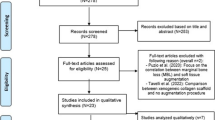Abstract
It has been shown earlier that it is possible to improve bone healing, to regenerate previously existing bone, and to create new bone by means of an osteopromotive membrane technique. The present study addresses the question of whether it is possible to combine this technique with a locally applied factor, stimulatory to osteogenesis. Circular transosseous ‘critical size’ defects in mandibles of rats were either implanted with recombinant human bone morphogenetic protein type 2 (rhBMP-2) or were left empty; half the number of implanted and half the number of empty defects were covered with an expanded polytetrafluoroethylene (e-PTFE) membrane (GORE-TEX®). Results were evaluated after 12 and 24 days of healing by a histomorphological scoring system. Implantation of rhBMP-2 alone resulted in bony bridging of the defect after only 12 days, but also in voluminous amounts of new bone outside the original defect area. When rhBMP-2 was combined with membrane, newly formed woven bone bridged the defect and the bone contour was maintained by the membrane. The combined treatment with membrane and rhBMP-2 demonstrated a significantly better bone healing than with e-PTFE membrane alone at both 12 days and 24 days of healing. It was concluded that rhBMP-2 has a strong osteoinductive potential and, in contrast to what was found earlier with other types of BMP preparations, this potential was retained when combining the rhBMP-2 with the osteopromotive membrane technique, yielding better bone healing than with the membrane alone, and at the same time maintaining the bone contour. This combination may have important therapeutic applications for osseous healing and in reconstructive surgery. The study also shows the importance of an appropriate carrier material when applying stimulatory substances to enhance bone formation in combination with a membrane.
Similar content being viewed by others
References
Linde A, Alberius P, Dahlin C, Bjurstam K, Sundin Y (1993) Osteopromotion. A soft-tissue exclusion principle using a membrane for bone healing and bone neogenesis. J Periodontol 64: 1116–1128
Tenenbaum HC (1990) Cellular origins and theories of differentiation of bone-forming cells. In: Hall BK (ed) Bone, vol 1: the osteoblast and osteocyte. Telford Press, Caldwell, NJ, pp 41–69
Baylink DJ, Finkelman RD, Mohan S (1993) Growth factors to stimulate bone formation. J Bone Miner Res 8:S565-S572
Urist MR (1965) Bone formation by autoinduction. Science 150: 893–899
Reddi AH, Huggins C (1972) Biochemical sequences in the transformation of normal fibroblasts in adolescent rats. Proc Natl Acad Sci USA 69:1601–1605
Urist MR, Strates BS (1971) Bone morphogenetic protein. J Dent Res 50:1392–1406
Kaban LB, Glowacki J (1981) Induced osteogenesis in the repair of experimental mandibular defects in rats. J Dent Res 60:1356–1364
Knutsen R, Mohan S, Wergedal J, Sampath K, Baylink DJ (1993) Osteogenic protein-1 stimulates proliferation and differentiation of human bone cells in vitro. Biochem Biophys Res Commun 194:1352–1358
Ripamonti U, Reddi AH (1992) Growth and morphogenetic factors in bone induction: role of osteogenin and related bone morphogenetic proteins in craniofacial and periodontal bone repair. Crit Rev Oral Biol Med 3:1–14
Wang EA, Rosen V, Cordes P, Hewick RM, Kriz MJ, Luxenberg DP, Sibley BS, Wozney JM (1988) Purification and characterization of other distinct bone-inducing factors. Proc Natl Acad Sci USA 85:9484–9488
Wozney JM, Rosen V, Celeste AJ, Mitsock LM, Whitters MJ, Kriz RW, Hewick RM, Wang EA (1988) Novel regulators of bone formation: molecular clones and activities. Science 242: 1528–1534
Ozkaynak E, Rueger DC, Drier EA, Corbett C, Ridge RJ, Sampath TK, Oppermann H (1990) OP-1 cDNA encodes an osteogenic protein in the TGF-beta family. EMBO J 9:2085–2093
Toriumi DM, Kotler HS, Luxenberg DP, Holtrop ME, Wang EA (1991) Mandibular reconstruction with a recombinant bone-inducing factor. Arch Otolaryngol Head Neck Surg 117:1101–1112
Dahlin C, Linde A, Röckert H (1993) Stimulation of early bone formation by the combination of an osteopromotive membrane technique and hyperbaric oxygen. Scand J Plast Reconstr Hand Surg 27:103–108
Hedner E, Linde A (in press) Effect of bone morphogenetic protein implantation in rat mandibular defects, covered by osteopromotive membranes. Eur J Oral Sci 103
Dahlin C, Linde A, Gottlow J, Nyman S (1988) Healing of bone defects by guided tissue regeneration. Plast Reconstr Surg 81: 672–676
Heiple KG, Chase SW, Hernon CH (1963) A comparative study of the healing process following different types of bone transplantation. J Bone Joint Surg 45:1593–1616
Schmitz JP, Hollinger JO (1985) The critical size defects as an experimental model for craniomandibulofacial nonunions. Clin Orthop Rel Res 205:299–308
Sandberg E, Dahlin C, Linde A (1993) Bone regeneration by the osteopromotion technique using bioabsorbable membranes. An experimental study in rats. J Oral Maxillofac Surg 51:1106–1114
Zellin G, Gritli-Linde A, Linde A (in press) Healing of mandibular defects with different biodegradable and non-biodegradable membranes. An experimental study in rats. Biomaterials
Takagi K, Urist MR (1982) The reaction of the dura to bone morphogenetic protein (BMP) in repair of skull defects. Ann Surg 196:100–109
Dahlin C, Lekholm U, Linde A (1991) Membrane-induced bone augmentation at titanium implants. A report of 10 fixtures followed from 1 to 3 years after loading. Int J Period Rest Dent 11:273–281
Dahlin C, Andersson L, Linde A (1991) Bone augmentation at fenestrated implants by an osteopromotive membrane technique. A controlled clinical study. Clin Oral Impl Res 2:159–165
Linde A, Thorén C, Dahlin C, Sandberg E (1993) Creation of new bone by an osteopromotive membrane technique. An experimental study in rats. J Oral Maxillofac Surg 51:892–897
Author information
Authors and Affiliations
Rights and permissions
About this article
Cite this article
Linde, A., Hedner, E. Recombinant bone morphogenetic protein-2 enhances bone healing, guided by osteopromotive e-PTFE membranes: An experimental study in rats. Calcif Tissue Int 56, 549–553 (1995). https://doi.org/10.1007/BF00298588
Received:
Accepted:
Issue Date:
DOI: https://doi.org/10.1007/BF00298588




